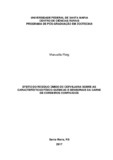| dc.creator | Fleig, Manuella | |
| dc.date.accessioned | 2017-09-13T14:10:06Z | |
| dc.date.available | 2017-09-13T14:10:06Z | |
| dc.date.issued | 2017-03-17 | |
| dc.identifier.uri | http://repositorio.ufsm.br/handle/1/11668 | |
| dc.description.abstract | The objective of this research was to evaluate the effect of increasing levels of substitution of sorghum silage by wet brewery residue (RUC) on the physical-chemical and sensorial characteristics of the meat of lambs finished in confinement. Twenty-four male, uncastrated, Suffolk lambs from single birth and kept in individual stalls were used. The treatments were constituted by four levels of substitution of sorghum silage by brewery residue being: 0; 33.5; 66.5 and 100% replacement. A voluminous: concentrate ratio of 50:50, based on MS, was used. The concentrate consisted of disintegrated corn, soybean meal and mineral mixture. Diets were isoprotein containing 18.81% PB. The animals were slaughtered when they reached the body condition score established in 3. The weight and proportion of fat increased linearly (P≤0.05) while the proportion of muscle decreased linearly (P≤0.05) in the carcass of the animals With the increase of RUC inclusion in the diets. The lambs' centesimal composition was not influenced by the RUC levels (P> 0.05), except for the ash content that presented increasing linear behavior (P≤0.05). There was no influence (P> 0.05) on the use of RUC on pH, cooking losses and lambs meat texture profile. The shear force decreased linearly (P≤0.05). Regarding meat color, the luminosity (L*) and the intensity of red (a*) were not influenced by the inclusion of RUC. The yellow intensity (b*) increased linearly (P≤0.05). Regarding attributes related to sensory analysis of lamb meat, no effect (P> 0.05) of inclusion of RUC in diets was observed. The use of RUC as a bulky food replacing sorghum silage in confined lamb diets allows the main physical-chemical and sensorial characteristics related to meat quality to be kept within the normal standards obtained for the ovine species. | eng |
| dc.language | por | por |
| dc.publisher | Universidade Federal de Santa Maria | por |
| dc.rights | Attribution-NonCommercial-NoDerivatives 4.0 International | * |
| dc.rights.uri | http://creativecommons.org/licenses/by-nc-nd/4.0/ | * |
| dc.subject | Qualidade de carne | por |
| dc.subject | Ovinocultura | por |
| dc.subject | Subprodutos agroindustriais | por |
| dc.subject | Maciez | por |
| dc.subject | Sabor | por |
| dc.title | Efeito do resíduo úmido de cervejaria sobre as características físico-químicas e sensoriais da carne de cordeiros confinados | por |
| dc.title.alternative | Effect of the wet brewery residue on the physical and chemical characteristics of confined lambs | eng |
| dc.type | Dissertação | por |
| dc.description.resumo | O objetivo dessa pesquisa foi avaliar o efeito de níveis crescentes de substituição da silagem de sorgo por resíduo úmido de cervejaria (RUC) sobre as características físico-químicas e sensoriais da carne de cordeiros terminados em confinamento. Foram utilizados 24 cordeiros machos, não castrados, da raça Suffolk, oriundos de parto simples e mantidos em baias individuais. Os tratamentos foram constituídos por quatro níveis de substituição de silagem de sorgo por resíduo de cervejaria sendo: 0; 33,5; 66,5 e 100% de substituição. Utilizou-se uma relação volumoso:concentrado de 50:50, em base da MS. O concentrado era constituído por milho desintegrado, farelo de soja e mistura mineral. As dietas eram isoprotéicas, contendo 18,81% de PB. Os animais foram abatidos quando atingiram o escore de condição corporal estabelecido em 3. O peso e a proporção de gordura aumentaram linearmente (P≤0,05) enquanto que a proporção de músculo diminuiu linearmente (P≤0,05) na carcaça dos animais com o incremento da inclusão de RUC nas dietas. A composição centesimal da carne dos cordeiros não foi influenciada pelos níveis de RUC (P>0,05), exceto o conteúdo de cinzas que apresentou comportamento linear crescente (P≤0,05). Não houve influência (P>0,05) do uso do RUC sobre o pH, as perdas por cozimento e perfil de textura da carne dos cordeiros. Já a força de cisalhamento diminuiu linearmente (P≤0,05). Em relação à cor da carne, a luminosidade (L*) e a intensidade de vermelho (a*) não foram influenciados pela inclusão de RUC. Já a intensidade de amarelo (b*) aumentou linearmente (P≤0,05). Quanto aos atributos relacionados a análise sensorial da carne dos cordeiros, não foi observado efeito (P>0,05) da inclusão do RUC nas dietas. A utilização de RUC como alimento volumoso em substituição a silagem de sorgo em dietas de cordeiros confinados permite que as principais características físico-químicas e sensoriais relacionadas com a qualidade da carne sejam mantidas dentro dos padrões normais obtidos para a espécie ovina. | por |
| dc.contributor.advisor1 | Carvalho, Sérgio | |
| dc.contributor.advisor1Lattes | http://lattes.cnpq.br/9114677690912835 | por |
| dc.contributor.referee1 | Saccol, Ana Gabriela de Freitas | |
| dc.contributor.referee1Lattes | http://lattes.cnpq.br/3550413713638568 | por |
| dc.contributor.referee2 | Vaz, Ricardo Zambarda | |
| dc.contributor.referee2Lattes | http://lattes.cnpq.br/1120109274579134 | por |
| dc.creator.Lattes | http://lattes.cnpq.br/7852625020265419 | por |
| dc.publisher.country | Brasil | por |
| dc.publisher.department | Zootecnia | por |
| dc.publisher.initials | UFSM | por |
| dc.publisher.program | Programa de Pós-Graduação em Zootecnia | por |
| dc.subject.cnpq | CNPQ::CIENCIAS AGRARIAS::ZOOTECNIA | por |
| dc.publisher.unidade | Centro de Ciências Rurais | por |



